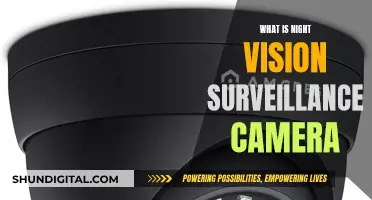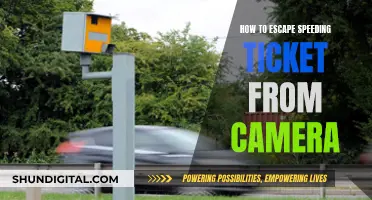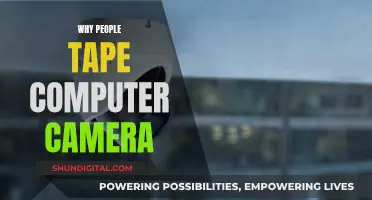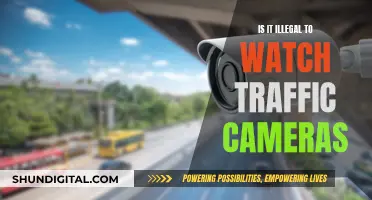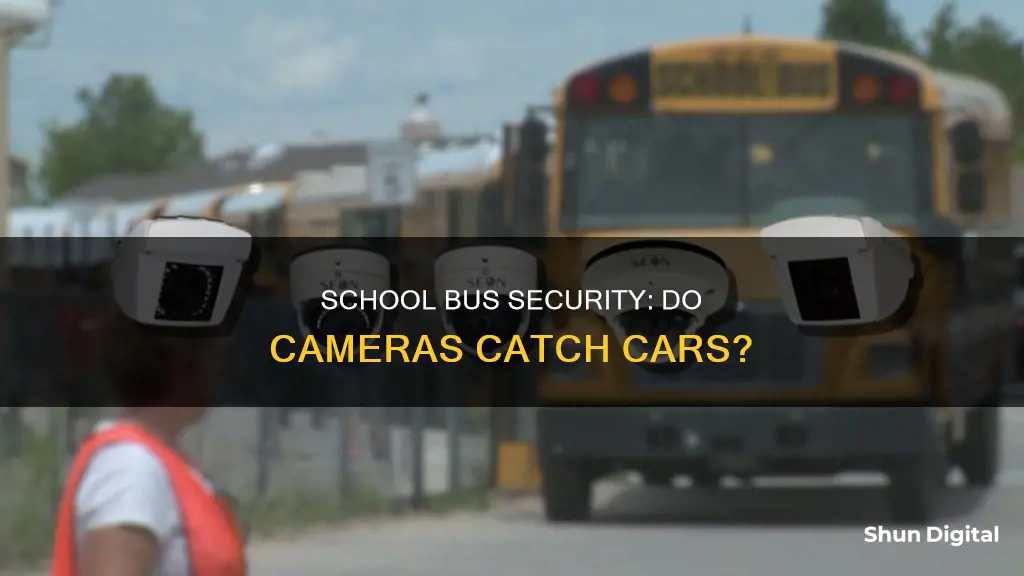
School buses are often equipped with cameras to enhance student safety and improve driver behaviour. These cameras are typically always on and recording, capturing incidents both inside and outside the bus. This helps to deter misconduct, promote responsible behaviour, and provide valuable evidence in case of emergencies or accidents. Additionally, school bus cameras can capture incidents of poor driving behaviour by cars driving by, such as drivers who speed up to avoid stopping for a school bus and put children's lives in danger. This footage can be sent to the police and used to issue tickets and citations for traffic violations.
| Characteristics | Values |
|---|---|
| Purpose | To improve student safety, monitor and enhance safety, capture incidents, deter misconduct, and provide evidence in case of emergencies or accidents |
| Activation | Continuously activated once the bus driver turns the engine on |
| Recording | Records in HD DVR; all seven exterior cameras record automatically |
| Footage Storage | The bus can store over seven full days of footage inside and outside the bus |
| Footage Transfer | The bus's computer automatically sends the footage over a secure cellular LTE network to headquarters for review |
| Stop-Arm Violation | The system triggers a stop-arm violation event, editing and sending a video excerpt to a safety specialist |
| Camera Angle | Multiple angles, including up to seven angles to view a violating license plate |
| Video File Evidence Admissibility | Requires a time and date stamp, vehicle ID#, and encryption to prevent tampering |
| Chain of Custody | Ensuring only authorized staff members have access to the video file evidence, which can be a challenge if the Transportation Director also drives the bus |
| Video Masking | Rendering uninvolved individuals non-viewable or unrecognizable in the playback video, especially important for underage children |
What You'll Learn

School bus cameras improve driver safety
School bus cameras are an increasingly popular tool for improving driver safety. These innovative solutions use AI analytics to enhance the safety of students and drivers, both inside and outside the bus. By recording stop-arm violations and providing a clear view of blind spots, these systems play a crucial role in maintaining a secure environment.
Improved Driver Awareness
One of the key benefits of school bus cameras is their ability to boost driver awareness. With exterior cameras, drivers can easily detect potential risks on the road, such as blind spots or incoming vehicles. This helps drivers stay vigilant and make better decisions, reducing the likelihood of accidents.
Enhanced Student Visibility
Exterior cameras also enhance student visibility, providing a clear view of the area around the bus. This is especially important when students are boarding or disembarking the bus, as it helps drivers ensure their safety. Additionally, in the unfortunate event of an incident, the cameras can provide valuable footage to help understand what happened.
Safety Protocol Adherence
AI-powered school bus camera systems can also monitor and analyze driver behaviour, including risky behaviours like distracted driving, speeding, and running red lights. Real-time alerts can be issued to drivers to maintain safety and encourage safe driving practices. This data can also be used by fleet managers to provide targeted coaching and improve overall driver performance.
Evidence for Law Enforcement
In the event of a stop-arm violation, school bus cameras can capture crucial evidence. Using advanced AI technology, cloud-connectivity, and a secure web platform, systems like BusPatrol can automatically generate evidence packages to support local law enforcement in taking appropriate action. This helps to create a culture of accountability and change driver behaviour, making the roads safer for everyone.
Improved Route Planning
School bus cameras, combined with GPS technology, can also assist in route planning and fleet management. By analyzing data from interior and exterior cameras, fleet managers can identify more efficient routes, saving time and money. This technology can also be used to ensure inspection compliance and make data-driven decisions to optimize operations.
In conclusion, school bus cameras play a vital role in improving driver safety. By enhancing driver awareness, student visibility, and adherence to safety protocols, these systems help create a safer environment for students, drivers, and other road users. Additionally, the data and evidence provided by these cameras can assist in law enforcement and route planning, further contributing to overall road safety.
Focusing on Self-Portraits: Camera Settings for Sharp Selfies
You may want to see also

They capture incidents inside the bus
School bus cameras are an important tool for improving safety and security for students, drivers, and school staff. While not all school buses are equipped with cameras, many now include them to monitor activity both inside and outside the bus.
Dual-faced dash cameras are an effective way to monitor, record, and deter misconduct inside the bus. They capture incidents such as bullying, vandalism, or unauthorized individuals, promoting a safe and respectful environment. The presence of cameras encourages responsible behaviour and discourages disruptive activities.
The footage from these cameras can be reviewed in real-time, allowing school administrators and transportation staff to address issues promptly. This enables schools to take swift and appropriate disciplinary action, ensuring the well-being of students and holding them accountable for their actions.
Additionally, in the event of accidents or emergencies, the recorded footage serves as crucial evidence for investigations and insurance claims. It helps reconstruct accidents, identify perpetrators, and determine liability.
Furthermore, advanced camera systems with features like enhanced low-light capture and night-vision technology ensure that no detail is missed, providing clear and comprehensive footage. This high-quality footage is invaluable for investigations and can make all the difference in ensuring student safety and incident resolution.
The use of school bus cameras is not just about monitoring but also about promoting positive behaviour and a culture of responsibility and respect among students. By capturing incidents inside the bus, these cameras play a vital role in creating a safer and more positive environment for students during their daily commutes.
Unlocking Camera Raw: Unfiltered Power for Your Photos
You may want to see also

Cameras can help with accident reconstruction
Cameras are everywhere in commercial districts, and their footage can be useful when accidents occur in adjacent traffic lanes. They can be used to supplement conventional traffic collision reconstruction methodology.
Finding Relevant Footage
When an accident occurs, investigators will look for security cameras in the area. However, finding a camera does not necessarily mean it will be useful. Some cameras are decoys, and others may not be pointing towards the relevant area. Time is also a factor, as many surveillance systems record over old footage. Therefore, any retrieval of video files must be done as soon as possible.
Video Quality
The quality of surveillance video will vary between systems. Image quality increases with pixel count. Environmental conditions, such as sunlight or dust on the lens, may also affect video quality.
Video Playback Speed
Video playback speed is the rate at which the images are displayed relative to time. A common capture rate for home security cameras is 30 frames per second (fps). Surveillance videos often display a timestamp, which can help determine the frame rate.
Vehicle Speed Analysis
Surveillance videos can be used to authenticate eyewitness statements, determine the colour of traffic lights, or verify headlight use. They can also be used to determine vehicle speed before or at the point of impact. This is done by tracking the vehicle's movements relative to stationary landmarks or reference lines.
Accident Reconstruction and Visibility Studies
In court, video evidence for accident reconstruction must accurately represent the accident scene and environmental factors. These include human factors (the interaction between the driver, vehicle and surroundings), environmental factors (roadway, weather, sun position, etc.), and vehicle factors (mechanical condition and performance).
Cameras can be positioned at the eye level of eyewitnesses to determine visibility issues and scene obstructions. This footage is then analysed to determine the perception-reaction time for the driver. Finally, a forensic video exhibit is produced to show the combined results from all three accident reconstruction factors.
A Global Snapshot: Annual Camera Production Numbers
You may want to see also

They deter poor driving behaviour around school buses
School bus cameras are an effective way to deter poor driving behaviour around school buses. By having cameras installed, drivers are more likely to adhere to traffic rules and maintain a responsible driving attitude. This is because they are aware that their actions are being recorded and can be held accountable for any unsafe behaviours.
School bus camera systems are designed to capture a comprehensive view of the bus's interior and exterior. This helps to identify and address any unsafe behaviours, such as aggressive driving, distracted driving, or any other actions that may compromise the safety of students. The presence of cameras encourages drivers to be more cautious and compliant with traffic regulations, particularly when driving near school buses.
In addition to promoting safer driving practices, school bus cameras also assist in accident investigations and liability determinations. In the event of an accident or incident, the recorded footage can be crucial for reconstructing the events leading up to it. This helps identify any violations or unsafe behaviours that may have contributed to the incident, ensuring that appropriate actions are taken to prevent similar occurrences in the future.
Moreover, school bus cameras can also capture incidents of motorists disregarding traffic laws related to school buses. For example, in many places, motorists are required by law to yield to school buses that have stopped to pick up or drop off passengers. School bus cameras can record motorists who violate these laws, endangering the lives of children. This footage can be used to track and issue tickets to offending drivers, enforcing school bus safety regulations.
The presence of school bus cameras not only deters poor driving behaviour but also provides valuable evidence to ensure the safety and well-being of students and drivers alike. It empowers authorities to take appropriate actions against unsafe driving practices, fostering a culture of responsible and cautious driving around school buses.
Charging Nixon Camera Batteries: A Step-by-Step Guide
You may want to see also

Footage can be used as evidence for insurance claims
School bus cameras are an effective tool for improving student safety and can also be used to capture valuable evidence in the event of accidents or insurance claims. The footage from these cameras can play a crucial role in insurance investigations, helping to determine liability and protect both the students and the school.
In the context of insurance claims, school bus camera footage can serve as indisputable evidence of what occurred. This can be especially important in situations where there are discrepancies between the accounts of the claimants and the insurance company. By reviewing the footage, insurance companies can accurately assess the situation and make informed decisions regarding liability and compensation.
The presence of cameras on school buses can also act as a deterrent for unsafe driving behaviours. Drivers are more likely to adhere to traffic rules and maintain responsible driving attitudes when they know their actions are being recorded. This proactive approach can reduce the likelihood of accidents and, consequently, the number of insurance claims.
Additionally, school bus cameras can capture incidents such as bullying, vandalism, or unauthorised individuals boarding the bus. This not only enhances student safety but also provides valuable evidence for any insurance claims arising from such incidents. For example, if an unauthorised individual causes damage to the bus or injures a student, the footage can be used to support an insurance claim for repairs or medical expenses.
It is worth noting that there may be legal considerations when using camera footage as evidence. For instance, in Georgia, there are specific rules regarding the attainment and use of video surveillance. These rules include restrictions on obtaining footage illegally, using unauthentic footage, or paying someone to record footage for the purpose of using it against a claimant. Therefore, it is essential to be aware of the relevant laws and regulations when utilising school bus camera footage as evidence for insurance claims.
Finding Your Dell Computer's Camera: A Quick Guide
You may want to see also
Frequently asked questions
Yes, school buses have cameras to record cars that do not stop when the bus stops. These are known as stop-arm cameras and they are always on and recording.
The cameras record incidents of cars passing school buses when they are stopped, which is a violation. The footage is then sent to the police.
The stop-arm camera system is continuously activated and begins recording in HD DVR when the bus engine is turned on. The system works by triggering stop-arm violation events, creating a video excerpt that is sent to safety specialists for review.



